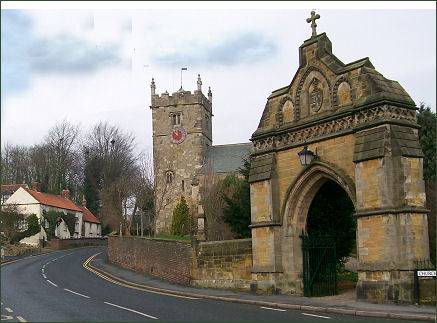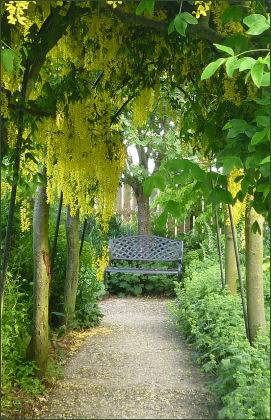Hunmanby
OS grid reference:- TA 099 775
 Hunmanby, known as the 'Gateway to the Yorkshire Wolds', is a large village on the edge of the Wolds. Once the largest village in Britain, it lies around 3 miles (4.8 km) to the south-west of Filey and within easy reach of Scarborough.
Hunmanby, known as the 'Gateway to the Yorkshire Wolds', is a large village on the edge of the Wolds. Once the largest village in Britain, it lies around 3 miles (4.8 km) to the south-west of Filey and within easy reach of Scarborough.
The village's name originated with from the Old Norse for 'farmstead of the hounds men', relating to the hunting of wolves on the Yorkshire Wolds, it is recorded in the Domesday Book as 'Hundemanbi'.
 After a landslip at Hunmanby in 1907 a British chariot burial site from the 1st or 2nd century BC was revealed containing a chariot and horse. A tumulus at a local farm was excavated, unearthing an ancient burial site containing 15 skeletons. Roman pottery and flint axe and arrowheads are often found in the area, proving it was occupied well before the arrival of the Vikings.
After a landslip at Hunmanby in 1907 a British chariot burial site from the 1st or 2nd century BC was revealed containing a chariot and horse. A tumulus at a local farm was excavated, unearthing an ancient burial site containing 15 skeletons. Roman pottery and flint axe and arrowheads are often found in the area, proving it was occupied well before the arrival of the Vikings.
Following the Norman conquest, William the Conqueror granted the lands around Hunmanby to Gilbert De Gant, who lived in a house outside the then town named Le Burlyn - Old French for wool house, which occupied the site where Low Hall now stands. Gilbert's son William founded nearby Bridlington Priory. The village is said to be the last place where King Stephen kept his wolfhounds.
The village contains a number of noteable buildings including Low Hall, the original hall, which dates from the eleventh century, and Hunmanby Hall, a Queen Anne building built from stone from Filey Brigg, to replace the original hall. Hunmanby Hall Golf is set in the picturesque grounds of the hall with spectacular views over Filey Bay and Bempton cliffs. Traces remain of a Norman motte and bailey fortification on Castle Hill.
The village still retains its market cross, although it is now headless and many of its traditional chalk houses, often thatched and dating back to the seventeenth and eighteenth centuries.
Other historical attractions include the charming twelfth century village church of All Saints, and a nineteenth century lock-up known as 'The Black Hole'. The White Swan pub, an historic Grade II listed old coaching inn has stood in the market place for many centuries. The pub offers bed and breakfast accommodation and serves food.
The Church of All Saints, situated at the centre of the village, is over 900 years old, the Domesday Book of 1086, referring to Hunmanby, mentions "There is a church there and a priest", but an earlier Saxon church is believed to have existed on the site before that time. Gilbert de Gant commenced work on the present church which was continued by his son Walter. The early work of the present building dates, therefore, from the late eleventh and early twelfth centuries. Lords of the Manor Shields are displayed as replicas high on the walls. The details of each shield is given on a plaque near the inner entrance door.
Hunmanby Grange is home to Wold Top Brewery, the beautiful 3-acre garden (pictured above right) has been created over the last 30 yrs from exposed open fields. Hedges and fences now provide shelter from wind, making series of gardens with year round interest and seasonal highlights. The garden is open to the public for charity on certain days. Tours are available by appointment only.
Hunmanby Gap (above left) boasts a large, flat sandy beach with a cliff top cafe and a large car park at the top of the hill.
Towns and Villages of Yorkshire
